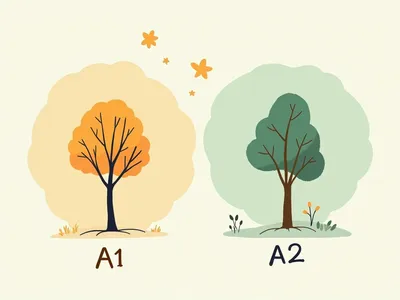
How do A1 level vocabulary lists differ from A2 level lists
Learn Essential English Vocabulary for Beginners – A1 Level: How do A1 level vocabulary lists differ from A2 level lists
The vocabulary lists for A1 and A2 levels in the Common European Framework of Reference for Languages (CEFR) differ primarily in terms of quantity, complexity, and contextual usage. Below are the main distinctions:
1. Vocabulary Size
- A1 Level (Beginner): Typically includes around 500–700 words, focusing on the most basic and essential vocabulary needed for everyday communication, such as greetings, numbers, days of the week, and basic nouns and verbs 1, 7.
- A2 Level (Elementary): Expands to approximately 1,000–1,500 words, introducing more specific vocabulary for everyday situations like shopping, employment, and local geography. It also includes more verbs, adjectives, and phrases to allow for slightly more complex communication 1, 7.
2. Complexity of Words
- A1 Vocabulary: Words are simple and concrete, often related to immediate needs or personal information (e.g., “name,” “house,” “food”). Grammar is limited to basic structures like present tense and simple questions.
- A2 Vocabulary: Introduces slightly more abstract or detailed terms (e.g., “essay,” “supporting details”) and includes vocabulary that supports simple conversations about past events or preferences. It also incorporates basic grammatical constructs like reflexive verbs and adjective declensions 5, 7.
3. Contextual Usage
- A1 Level: Focuses on survival-level communication such as introducing oneself, asking for directions, or ordering food. The vocabulary is geared toward recognizing and using familiar expressions in slow, clear speech.
- A2 Level: Allows learners to engage in simple dialogues about everyday topics like family, hobbies, or work. It supports understanding frequently used expressions in routine tasks and describing personal experiences in basic terms 10, 11.
4. Topics Covered
- A1 Vocabulary Topics: Includes greetings, numbers, colors, family members, basic actions (e.g., “run,” “eat”), and common objects.
- A2 Vocabulary Topics: Expands to include more situational vocabulary such as shopping terms (“receipt,” “price”), travel-related words (“ticket,” “train”), and workplace language (“job,” “salary”) 4, 17.
5. Learning Time
- The A1 level is usually faster to master because it focuses on foundational words and phrases. A2 requires more time due to its broader word list and added grammatical structures (e.g., comparatives, superlatives) 1.
In summary, A1 vocabulary provides the foundation for basic communication with essential words and phrases, while A2 builds upon this by introducing a wider range of vocabulary that enables learners to handle more specific situations with slightly greater linguistic complexity.